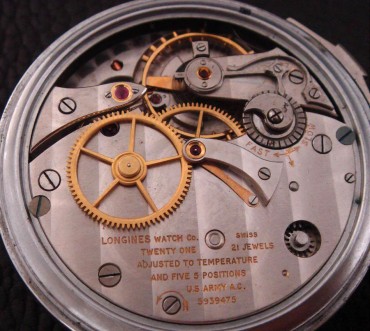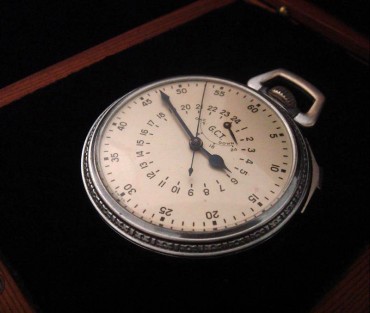
Item: W2453
Watch's origin: Swiss
Number of jewels: 21
Case: Longines/Keystone
Manufacturer: Longines
Type of Watch: Pocket
Type: Open-Face
Size: 18s
Composition: Base-Metal
Other Attributes:
Chronograph
Military
Mint
With Box
Price: $2,995.00
One of the rarest horological works we’ve had the honor to offer, this Longines “A-9” Master Navigation watch, ordered by the U.S. Government prior to WWII, was limited to one small run and served as the blueprint for Aeronautical Navigational watches thereafter.
The Longines Watch Company, founded in 1832, is known for producing high-quality timepieces and has been associated with many innovations and developments in the history of horology, especially the calibration and production of precision chronometers during the first half of the 20th century.
 Early aviators routinely turned to Longines for problem-solving and exactitude: At the time, a reliable timepiece was critical for navigation purposes, especially for determining longitude. General Francesco De Pinedo, the Marquis of Italy and aviation pioneer used Longines navigational timepieces exclusively during his Rome to Tokyo flight in 1925 and his Four-Continent Flight – covering 25,000 miles – in 1927. That same year, Charles Lindbergh wore a Longines “Weems” navigational timepiece on his Transatlantic flight. Admiral Richard E. Byrd worked directly with Longines to design a timing and navigation instrument for his historic flight over the South Pole in 1929. Amelia Earhart, Howard Hughes, Elinor Smith, Sir Charles Kingford Smith – all relied solely on the genius of Longines to guide them in their explorations.
Early aviators routinely turned to Longines for problem-solving and exactitude: At the time, a reliable timepiece was critical for navigation purposes, especially for determining longitude. General Francesco De Pinedo, the Marquis of Italy and aviation pioneer used Longines navigational timepieces exclusively during his Rome to Tokyo flight in 1925 and his Four-Continent Flight – covering 25,000 miles – in 1927. That same year, Charles Lindbergh wore a Longines “Weems” navigational timepiece on his Transatlantic flight. Admiral Richard E. Byrd worked directly with Longines to design a timing and navigation instrument for his historic flight over the South Pole in 1929. Amelia Earhart, Howard Hughes, Elinor Smith, Sir Charles Kingford Smith – all relied solely on the genius of Longines to guide them in their explorations.
It is no wonder that the U.S. government chose Longines Watch Company to design and provide a master chronograph for the long-range aeronautical needs of the Army Air Corps. The military had a tall-order indeed: a master chronograph precise enough for air navigation, yet resilient enough to be hand-held without the constraints of a gimbaled box.
Longines responded with a master navigation watch; a portable chronometer the size of a large pocket watch that could be used with sextant operations. The master engineers at Longines used one of the most venerable of all chronometer movements as their vehicle – the caliber 21.29; slightly larger than an 18 size pocket watch and one of the most precise timekeeping instruments available.
The master watchmakers of Longines designed a sliding side piece that activated a brake on the balance, allowing the mechanism to be stopped and started at will. When stopped with the second hand at “60,” it could then be set and synchronized – hours, minutes and seconds – with a master chronometer or a radio time signal. The large center second hand combined with the oversized seconds dial facilitated accurate reading. Thus was born the “A-9;” a marvel of horological art and exactly what military aviators needed.
Longines of Switzerland engineered and produced the A-9 mechanism, then sold it to their American counterpart, Longines-Wittnauer, who in turn cased the novel precision instruments and provided them to the U.S. military.
 The U.S. military used the design of the A-9 as inspiration for their WWII-era pendant-hack navigational watches produced by American watchmakers Hamilton, Elgin and Waltham.
The U.S. military used the design of the A-9 as inspiration for their WWII-era pendant-hack navigational watches produced by American watchmakers Hamilton, Elgin and Waltham.
The A-9 is an exceptionally rare work of horological art and history. The four examples we’ve tracked down all have Longines serial numbers within a 250 of what might be its first and only production run, between late 1939 and 1940.
We’re intensely pleased to offer an inspirational work of horological, military and aviation history: an original Longines A-9 master navigation pocket watch -blueprint for all Allied Master Navigation watches of WWII.
Ours is serial number 5939475, invoiced to the United States on May 31, 1940. Dial, mechanism and case are all completely original to the piece.
It features a 21 jewel, stem wind and set cal. 21.29 movement with lever escapement and micrometric regulator with its characteristic revolutionary hack lever slide on the side of the case. Marked “Longines Watch Co./TWENTY ONE/21 Jewels/ADJUSTED TO TEMPERATURE AND 5 POSITIONS/U.S. ARMY A.C. 5939475; its dial is completely original and magnificent, with Arabic numeral silver G.C.T. 24 hour configuration; outer seconds band and dial with wind indicator. Hands are plum blued and exquisite.
Case is correct, original and unassigned; meaning, it might have been used for design or research purposes – certainly fascinating in its own right.
We’re pleased to offer this historic work of horological engineering in a custom-fitted, velvet-lined presentation box.
Please take a moment to admire the images of this work of horological art. For more information on the history of the chronometer and horological engineering in general, I encourage you to get a copy of “Revolution in Time” by David Landes. In fact, I’ll include a copy of the book with the purchase of this piece. Also, please make sure you have a copy of Marvin E. Whitney’s Military Timepieces in your library.